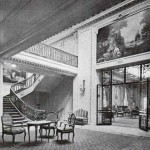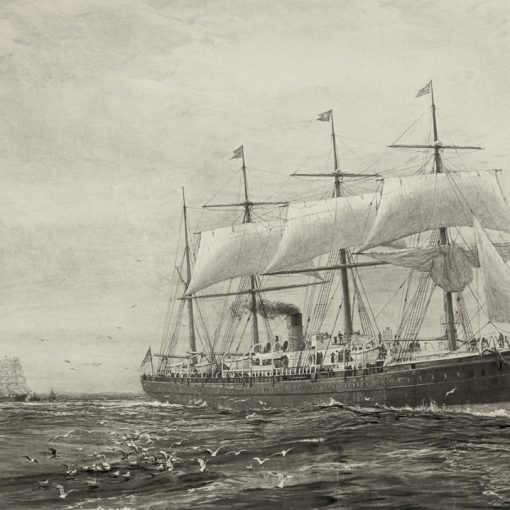1922 – 1940
Also known as Bismarck
Ever since the Cunard Line and the White Star Line had launched their giant ships, from the Lusitania in 1906 to the Titanic in 1911, Germany had been in the background. The Hamburg-Amerika Line had not owned a prestige-vessel since the very first years of the century. The company’s managing director Albert Ballin wanted to show the world how splendid German shipbuilding still was. He placed an order to the Blohm and Voss shipyard in Hamburg, consisting of the request to receive three large ocean liners, all above 50,000 tons. The first of these ships was to become the Imperator (52,226 tons) which was launched in May 1912. After that came the Vaterland (54,282 tons) in 1914.
The Vaterland had only been in service for the Hamburg-Amerika Line for a very short time when she was interned in New York harbour by the Americans when the great war began in 1914. Also the Imperator was taken over by the Americans. She sailed as the U.S.S. Imperator as a troop transporter during the war. It is ironic that these ships, built for Germany’s pride, carried American troops to Europe in order to fight the Germans.
The third ship, decided to be named Bismarck was still unfinished when World War 1 broke out. She had been launched on June 20, 1914, but all work on her was suspended and the hull was left to rust in the shipyard. Both the Imperator and the Vaterland played important roles in the war as troopers for the Americans, but the Bismarck remained where she was with no war tasks whatsoever. Germany was confident they would win the war, and the next plan for the Bismarck was to sail a world cruise with the German emperor on board, to receive the world’s congratulations.
As history would have it, Germany did not win the war. All of Ballin’s three giant vessels were handed over to Great Britain and the United States. Imperator was given to Cunard, and renamed Berengaria she became the company’s flagship. Vaterland was given to the Americans and was renamed Leviathan. She too received the rank of flagship. The unfinished Bismarck, which would have – when completed – a gross tonnage of over 56,000 tons, would become the largest ship in the world. As a replacement for the lost Britannic, the White Star Line was given this mighty vessel.
Since the Bismarck remained in Germany, incomplete, Britain demanded that the ship’s completion would be made at Blohm and Voss, but under White Star Line’s shipbuilding company Harland and Wolff’s supervision. In 1920, during the Bismarck’s completion, the ship caught fire and was badly damaged. Of course, sabotage was suspected, since quite naturally, the Germans did not wish to part with ‘their’ ship. However, the Bismarck was not mortally wounded and the work continued until 1922 when the ship was finished. Painted in White Star Line’s company colours, she sailed immediately to Liverpool where she began her sea trials. After these had been carried through her new company changed the ship’s name on April 12 to the suitable Majestic. Her running mates were to be the Olympic and another ex-German ship, the Homeric (formerly the Columbus).
On May 12, 1922 the Majestic steamed out on her maiden voyage from Southampton to New York. Her captain was White Star Line’s commodore Captain Bertram Hayes, who had been transferred from the Olympic. The ship was a magnificent sight with her three buff funnels and long black hull. You could easily see the resemblance between the Olympic-class liners, which now was very suitable because of her 45,000-ton running mate. Of the Majestic’s three funnels, only two worked. The third held the ventilation plant. The two working funnel’s smoke went through the sides of the ship, so that the area below the funnels could be used for staterooms. This mid-ship area was occupied only by first class staterooms. Second class was located aft on the superstructure, and steerage at the two ends of the ship. Just as the Olympic, the Majestic had her promenade deck opened up for the entire length of the superstructure.
In 1923, the Majestic proved her swiftness with an average Atlantic crossing speed of 24.75 knots. That made her the second fastest passenger ship in the world. The fastest was, of course, the Mauretania with her record speed of 26.06 knots across the Atlantic. On that same year, the Majestic carried 2,625 passengers; the highest number carried on a White Star ship ever.
The next year showed that the Majestic actually was an old ship, launched in 1914. Alongside her hull she developed a crack large enough to take her to Belfast for reparation. The hull plates were strengthened, but her hull was always thereafter in doubt. But the ship carried on with her work, and in 1925 she made her best crossing ever, averaging 25 knots across the Atlantic.
In 1928, the ship was taken in for a major overhaul at Boston and the forward end of the promenade deck was enclosed with glass. Sooner or later all ships with their entire promenade decks open seemed to have them glassed in. Other examples are Adriatic and Titanic. The Boston Navy Dockyard was chosen because there was no graving dock large enough in Britain to accommodate the now 56,620-ton Majestic. In late February the ship resumed service.
Two years later, the situation for the shipping companies was precarious. The crash on Wall Street had occurred in 1929, and everything seemed to point downwards. No one could afford an expensive crossing, so the White Star Line decided to let their big ships cruise on three and a half days to Halifax in the seven-day stay at New York. This brought some extra money for the company, but the great heyday of the Atlantic liners was definitely over.
In 1934, as a result of the Depression, Cunard and White Star agreed on a merger between the two companies. A new one was formed, and in July, the Majestic was taken over by the Cunard-White Star Line. In this new company, she replaced the ageing Mauretania. The same year she ran aground at Calshot but managed to get off with the tide. In October, during a heavy storm, a giant wave crushed her bridge windows and injured the First officer and the captain, Commodore Edgar J. Trant. The captain, who would turn out to be White Star’s last commodore, was taken to the Majestic’s hospital, where he remained for the rest of the voyage. Commodore Trant never sailed again after this accident.
When the French’s Normandie entered service in 1935, the Majestic was finally replaced as the largest ship in the world. Even though younger than Berengaria and Aquitania, the Majestic was taken out of service before them in 1936 and replaced by Britain’s 81,000-ton Normandie rival Queen Mary. The Majestic had completed 207 successful voyages to New York, but had only seen 14 years of actual service. But as her hull was from 1913, she showed evidence of being old. On May 15, she was sold for £115,000 to Thos. W. Ward for demolition. In July the Majestic was saved though, by the Admiralty, which purchased the ship. They needed her as a cadet’s training ship, and after a £472,000 conversion by Thornycroft at Southampton, which included a removal of the black funnel-tops (so that the ship could pass under the Forth Bridge), the ship was handed over to the Admiralty. Still in White Star colours, the ship was renamed H.M.S. Caledonia. As a training ship, she remained at shore and her sewage systems were connected to land. In 1937, the ship left Southampton for her new base at Rosyth, Scotland.
When World War 2 began in September 1939, all the cadets on board the old Majestic were withdrawn to shore duties. As the ship’s berth was taken by another ship, Caledonia was anchored in the Firth of Forth, still in the Navy base area. The end came on September 29, when the ship caught fire and sank. She was completely destroyed, and in March 1940, the vessel, once again, was sold to Thos. W. Ward for demolition. They cut the ship down to the waterline (except for the forepeak to assist towage), and three years later the remains of the third largest vessel in the world were towed to the scrap yard. And so ended the days for the greatest ship ever owned by the White Star Line.
Specifications
- 955.8 feet (291.9 m) long
- 100.1 feet (30.6 m) wide
- 56,551 gross tons
- Four Parsons-B & W direct drive steam turbines powering four propellers
- 23.5 knot service speed
- Passenger capacity of 2,145 people













